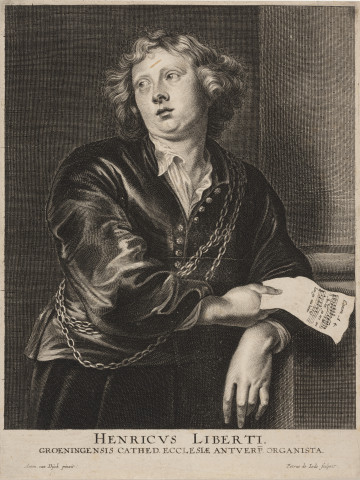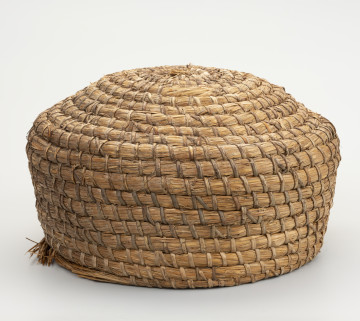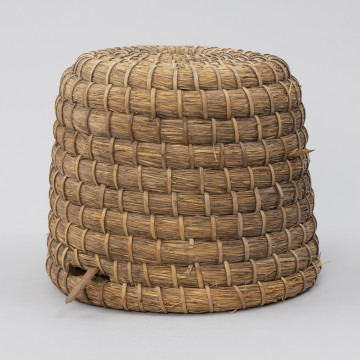
Portrait
circa 1632
National Museum in Szczecin
Usually we do not think about how many objects we use every day. Even less often do we think about how their appearance and function have changed over the years. Would you guess quicker the purpose of objects from 100 or 1000 years ago? To make it easier, the presented exhibits have been grouped into five categories: archaeology, dining room, celebration, hygiene and work.
Peculiarities from the category:
Archaeology is the science that explains how people lived in the past. It does this on the basis of objects obtained from the ground during excavations. Take on the role of an archaeologist and try to see if you can identify the objects he has found.
The story of the invention of the fibula is similar to that of many other objects. Practical reasons were decisive. Our ancestors, regardless of the season or place of living, needed something with which they could fasten their clothes. More than three thousand years ago, when the first fibulae appeared, neither buttons nor zippers or snaps were known yet. For almost two thousand years, fibula was perfect for furs and coats. At that time it was fastened under the neck or at breast height.
The fibula presented here is about two thousand years old.
The oldest skates found are about five thousand years old. They were made from animal bones and attached to the feet using thongs or thin strips of leather.
Interestingly, skates were originally not just for fun. They were treated as a reliable method of getting around during cold winters. Frozen rivers could make it impossible, for example, to go to a neighbouring settlement. Skates were the solution.
This object is about 800 years old. However, the first skates made of metal – similar to those we know today – did not appear until around 400 years ago.
The principle of such a rattle is the same as contemporary one. In former times, for example, pebbles were placed inside, which made a sound when shaken. The rattle is not perfectly round, but has small lumps on its surface. It was made of clay and then burnt in the fire to make it durable. This was undoubtedly successful. The object on display could be up to three thousand years old.
Many researchers believe that rattles were not only used for playing. Perhaps shaking them was also supposed to ward off evil spirits. It is possible that they were used, for example, at funerals.
Peculiarities from the category:
The dining room is the room where meals are eaten. Its basic equipment is, of course, a table and chairs. However, it is also worth paying attention to what is on the table. And it is not only about the food, but also about the objects which are useful during the meals. See if you can guess their functions.
Its use is very simple. Just open it and place a lemon half in the porcelain bowl like a strainer. Then press with all your might on the other part of the object, which crushes the fruit and allows the juice to come out through the holes. Similar hand tools are still used in the kitchen today – not only for fruits, but also for squeezing garlic, for example. However, nowadays we use mechanical juicers more and more often.
The first lemons appeared on Polish tables as early as in the 14th century. At first, they were used as a spice for fish and meat dishes and preserves, but only on royal tables, as they were very expensive. The featured squeezer dates back to the 19th century, when lemons were more readily available.
In Europe cocoa beans, from which chocolate is made, appeared in the 16th century in Spain. They were imported from South America. Before chocolate bars were made, however, it was served in the form of a drink. Interestingly, it was not sweet at all, but rather bitter. This type of pitcher was used to prepare and serve liquid chocolate. There is a hole in the lid. A stirrer was inserted through this hole and with a few stirs the drink became thicker. In the beginning only the richest people could afford to taste chocolate. Soon, however, it became popular all over Europe.
The presented pitcher was made in the early 18th century.
In the past salt was an extremely valuable and expensive spice. For this reason, the vessel in which it was served also had to be unique. It was open at the top and the salt was scooped with a small spoon like a spatula.
The salt cellar was placed on the table in a special place, in front of the most important person. At that time the person was said to sit “behind the salt”, i.e. in the most honoured place. Salt cellars were richly decorated, because their appearance was supposed to dazzle the assembled guests. Beautiful vessels also testified to the wealth of their owner.
The presented salt cellar dates back to the 18th century.
Peculiarities from the category:
Celebrations can be of a various nature. Sometimes it is a small family gathering, and another time with invited guests, many of whom are meeting for the first time in their lives. A celebration is usually linked to a holiday or important event. Try to guess what these objects are and during which celebrations they were used.
In the 19th century grand balls were an extremely popular pastime. Dances such as the waltz or polka were danced at these balls. To be able to take part in a ball, one had to know the steps and figures, so they were taught from a childhood.
Each lady invited to the ball received a card. In fact, it was a notebook in which the order of the songs was written. The owner of the card wrote down the names of the men who asked her to dance. There was no room for spontaneity, because everything was carefully planned.
Of course, every lady dreamed of having her dance card all filled up. This meant that she would certainly not be bored that evening.
This object is a special kind of cannon. It is used not in war but, on the contrary, in peacetime. Due to its small size, it would not work well on the battlefield.
Such a cannon was used for cheering during solemn and joyful moments. It was often used during toasts to emphasise the importance of the moment. Sometimes, when the guests behaved exceptionally loudly, the salute gun was fired to attract their attention. Then silence would fall for a while. Of course, at that time no cannonballs were used, just gunpowder, which, when set alight, caused a huge bang.
The presented salute gun was made in the 18th century.
This gift was created around 170 years ago in Pomerania. At that time few marriages were made for love. Very often the decision to marry was taken by the parents. They were mainly guided by the family’s wealth and position. It was also important whether the family had a good reputation. In the guide book of that period we can read that a daughter should not be forced to marry, if it would make her unhappy. On the other hand, if the girl’s decision turned out to be unwise and imprudent, it was necessary to oppose it.
Once the wedding had taken place, everything followed a fixed pattern. A popular custom was for the groom to give his future wife a gift in the form of a decorative box. The bride-to-be was given a present in the form of an ornamental box, in which she could keep, for example, her jewellery or something of value.
Peculiarities from the category:
Hygiene is primarily associated with washing and bathing. In fact, however, it is a much broader category. It includes things connected with the functioning of our body, but also those that help us take care of our appearance. The items presented here used to be familiar to everyone. Today we look at them with astonishment. Can you recognise them?
It was used to dispose of excess saliva. Spittoons were placed in homes, but also, for example, in schools, bars, trains and offices. For many years spitting into them was considered absolutely normal. Their great popularity was connected, among other things, with the fashion for chewing tobacco leaves, which increased the secretion of saliva. Another reason was the ban on spitting on the street or pavement, because at some point it was considered unhygienic and rude. It was a different matter to spit in a container that had been set up, and then emptied and cleaned regularly. Spittoons ceased to be used in Poland only about 70 years ago.
The frogs on display are from China and were created in the 19th century.
In Europe glasses appeared in the 14th century. Is it possible that people did not have problems with their eyesight before then? Of course not. They simply did not know how to improve it. They did, however, make some attempts. One of the ancient historians and writers pointed out that the Roman emperor, when watching gladiator fights, did it through... an emerald applied to his eye. So, for centuries there has been a search for materials that could help sharpen the eyesight.
The item on display dates from 19th century in France. It has two soft pads used to rub the glasses. Even such a small and practical object was not lacking in decoration. On the outside there is an embroidered pattern: a red and blue flower with leaves.
Peculiarities from the category:
Nowadays, the most popular tool for work is the computer. The development of technology has also meant that many activities are performed by machines. In the past, however, man was surrounded by numerous objects which allowed him to perform everyday tasks. See if you can guess the purpose of these tools.
It was made up of three basic elements. First of all, a simple metal bar on which loop of string is placed. Secondly, a hook on which we place the goods to be weighed. Thirdly, a fixed weight, which is placed on the side opposite the hook. In this case the weight is in the shape of a slightly flattened ball.
After hanging the goods, we have to move the eye of the strap, so that the bar hangs perfectly horizontally. Then we can read the weight of the goods from the scale on the bar, at the place where the bar is located.
This way of weighing was used for centuries, although it was not very precise. It was difficult to weigh really large and heavy objects.
Glass is an extremely fragile material. However, the craftsman with the right experience can successfully master the difficult art of glass cutting. For this he needs the right tool. It consists of three parts. Firstly, there is a handle which has to be gripped – in this case made of ivory. Secondly, a metal extension to the handle, which is topped off with a third element, the diamond. The word “diamond” in Greek means “indestructible”. This is because this mineral is extremely hard. Despite advances in technology, diamond cutting is still considered a reliable method of glass processing today.
Wherever man had access to water, fishing has developed over the centuries. At the same time, various tools were developed to help with the catch. However, in order to choose the right technique, it was also necessary to have knowledge of fish.
A characteristic of eels is that they live close to the bottom and bury themselves in the mud for the winter. Therefore the fisherman’s task was to drill a hole in the frozen river or lake and then direct the leister to the very bottom. Repeating this operation several times usually resulted in the eel being stuck on a sharp spike in the middle of the tool.
Bodies have now been banned because they injure fish.
Znaleziono 0 obiektów

Dyck, Anthony van
circa 1632
National Museum in Szczecin

unknown
1965
National Museum in Szczecin

unknown
1890 — 1910
National Museum in Szczecin
DISCOVER this TOPIC
Museum of King Jan III's Palace at Wilanów
DISCOVER this PATH
Educational path

